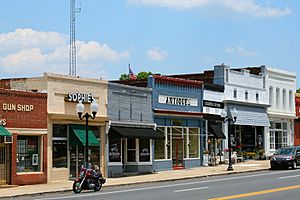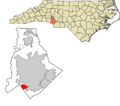Pineville, North Carolina facts for kids
Quick facts for kids
Pineville, North Carolina
|
|
|---|---|

Main Street in the Historic Pineville Town Center.
|
|

Location of Pineville, North Carolina
|
|
| Country | |
| State | |
| County | Mecklenburg |
| Incorporated | 1873 |
| Named for | The large and abundant pines that cast their shadows over the community |
| Area | |
| • Total | 6.68 sq mi (17.29 km2) |
| • Land | 6.64 sq mi (17.20 km2) |
| • Water | 0.04 sq mi (0.09 km2) |
| Elevation | 554 ft (169 m) |
| Population
(2020)
|
|
| • Total | 10,602 |
| • Density | 1,596.45/sq mi (616.40/km2) |
| Time zone | UTC-5 (Eastern (EST)) |
| • Summer (DST) | UTC-4 (EDT) |
| ZIP code |
28134
|
| Area code(s) | 704 |
| FIPS code | 37-52220 |
| GNIS feature ID | 2407125 |
| Website | www.pinevillenc.gov |
Pineville is a town in the southern part of Mecklenburg County, North Carolina, United States. It is a suburban town that is part of the larger Charlotte metropolitan area. Pineville is located in the Waxhaws district, between the cities of Charlotte and Fort Mill.
Contents
History of Pineville
Pineville was once known as a place for trading mules. This was during the time of the Charlotte 'gold rush'. Back then, Pineville was called 'Morrow's Turnout'. It was located where two important Native American trading routes met. There were large fields where animals used for trade and travel could rest.
How Pineville Got Its Name
Pineville officially became a town in 1873. The name Pineville came about in 1852. This was when the Charlotte & Columbia Railroad built tracks through the area. The railroad wanted a more modern name for the stop. They chose Pineville because of the many tall pine trees in the area.
Growth and Development
In the 1890s, a cotton mill called Dover Yarn Mills opened in Pineville. This mill later became Cone Mills, Inc. It operated in the town until 1991. The old part of Pineville, just one block long, was a busy place for shops. Today, this area still has many unique shops and restaurants.
The town grew a lot when the first part of I-485 opened. This highway was meant to help traffic go around Charlotte. However, it also passed through Pineville. Because of this, land near Pineville's I-485 exits developed into a huge shopping area. It is now the largest shopping district in North Carolina. Pineville has the Carolina Place Mall and many other stores.
Birthplace of a President
Pineville is the birthplace of James K. Polk, who was the 11th president of the United States. His original home is no longer there. However, an old cabin from that time period is kept at the site. It shows what his birthplace might have looked like.
This area is now a state historic site. It has two log cabins that have been rebuilt. These cabins are from the local area and were built around 1790. They are decorated with old furniture like what the Polk family would have used. There is a main house, a cookhouse, and a log barn. You can take tours with guides dressed in old-fashioned clothes.
The site also has a museum. It shows a short film about James Knox Polk's life. You can also see old clothes and other items from that time. A monument was put up in 1904 where the cabins are now. The state of North Carolina moved the monument in 1964 and again in 1968 to its current spot near the visitor center.
Geography
Pineville covers an area of about 17.29 square kilometers (6.68 square miles). Almost all of this area is land.
Population Information
| Historical population | |||
|---|---|---|---|
| Census | Pop. | %± | |
| 1900 | 585 | — | |
| 1910 | 688 | 17.6% | |
| 1920 | 650 | −5.5% | |
| 1930 | 1,108 | 70.5% | |
| 1940 | 1,144 | 3.2% | |
| 1950 | 1,373 | 20.0% | |
| 1960 | 1,514 | 10.3% | |
| 1970 | 1,948 | 28.7% | |
| 1980 | 1,525 | −21.7% | |
| 1990 | 2,970 | 94.8% | |
| 2000 | 3,449 | 16.1% | |
| 2010 | 7,479 | 116.8% | |
| 2020 | 10,602 | 41.8% | |
| U.S. Decennial Census | |||
2020 Census Details
A census is a count of the population. The 2020 United States census showed that 10,602 people lived in Pineville. There were 3,732 households and 1,934 families in the town.
The table below shows the different groups of people living in Pineville in 2020:
| Race | Number | Percentage |
|---|---|---|
| White (non-Hispanic) | 4,855 | 45.79% |
| Black or African American (non-Hispanic) | 2,425 | 22.87% |
| Native American | 31 | 0.29% |
| Asian | 596 | 5.62% |
| Pacific Islander | 9 | 0.08% |
| Other/Mixed | 438 | 4.13% |
| Hispanic or Latino | 2,248 | 21.2% |
Population in 2010
In the 2010 United States census, Pineville had a population of 7,479 people.
Healthcare
Pineville has a hospital called Atrium Health Pineville. It is a 206-bed hospital that opened in 1987. It is part of the Atrium Health system.
Education
Schools in Pineville are part of the Charlotte-Mecklenburg Schools district.
Most students in Pineville go to Pineville Elementary School. Some students attend Smithfield Elementary School. All students then go to Quail Hollow Middle School. After that, they attend South Mecklenburg High School.
Starting in the 2024-2025 school year, many students in Pineville will go to a new high school. It is called Ballantyne Ridge. Some areas will still go to South Mecklenburg High School. Students who are seniors in the 2024-2025 school year will stay at South Mecklenburg, no matter where they live.
Notable People
Here are some well-known people who have connections to Pineville:
- Julianna Cannamela – an artistic gymnast
- Lauren Cholewinski – an Olympic speed skater
- Julius Daniels – an American Piedmont blues musician
- Walter Davis – an NBA player who was a 6-time All-Star
- Lew Massey – a professional basketball player
- James K. Polk – the 11th president of the United States
- Erwin Potts – the first CEO of the McClatchy Company who was not a member of the McClatchy family
- Charles T. Robertson Jr. – a retired general from the United States Air Force
- Mary Tucker – an American sport shooter
Images for kids
See also
 In Spanish: Pineville para niños
In Spanish: Pineville para niños





